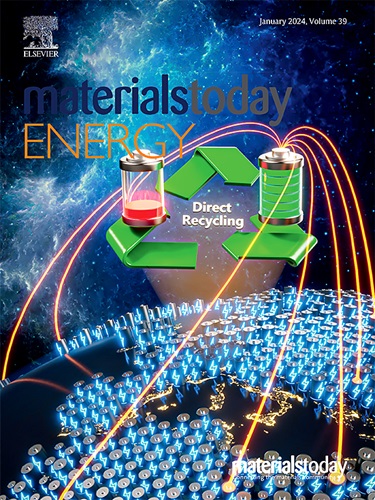控制高效 Sb2S3 和低 Se 含量 Sb2SeyS3-y 室内光伏的优先取向
IF 8.6
2区 材料科学
Q1 CHEMISTRY, PHYSICAL
引用次数: 0
摘要
由于具有 1.75 eV 的适当直接带隙、高元素丰度、低毒性、稳定性和单相性,SbS 是一种很有前途的室内光伏吸收材料。考虑到室内照明辐照度非常低,产生的载流子数相对较少,且 SbS 为准一维晶体结构,因此 SbS 的优先取向控制对于提高 SbS 室内光伏的功率转换效率(PCE)非常重要。本文采用化学沉积法制备了 SbS 和低 Se 含量的 SbSeS 薄膜,并通过在生长溶液中引入 SbCl 和硒脲来控制 SbS 薄膜的优先取向。通过引入 EDTA-2Na 来调节低硒含量 SbSeS 薄膜中 S 和 Se 分布的均匀性。使用色温为 3347 K、照度为 1000 lux 的暖白光 LED,SbS 和低硒含量 SbSeS 室内光伏器件的 PCE 分别达到了 16.58% 和 17.62%,这是目前锑瑀室内光伏器件的最高 PCE。因此,通过在生长溶液中引入氯化锑和硒脲来控制优先取向,是制造高效 SbS 和低硒含量 SbSeS 室内光伏器件的有效策略。本文章由计算机程序翻译,如有差异,请以英文原文为准。
The preferential orientation controlling for efficient Sb2S3 and low Se content Sb2SeyS3-y indoor photovoltaics
SbS is a promising absorber material for indoor photovoltaics due to the appropriate direct bandgap of 1.75 eV, high element abundance, low toxicity, stability, and single phase. Considering the indoor lighting irradiance is very low and the resulting carrier numbers are relatively less and SbS is quasi-one-dimensional crystal structure, the preferential orientation controlling of SbS is very important to improve the power conversion efficiency (PCE) of SbS indoor photovoltaics. Herein, SbS and low Se content SbSeS films are prepared by chemical bath deposition and the preferential orientation of SbS films is controlled by introducing SbCl and selenourea in the growth solution. The uniformity of the S and Se distribution in low Se content SbSeS films is adjusted by introducing EDTA-2Na. Using the warm white LED with a color temperature of 3347 K and illuminance of 1000 lux, SbS and low Se content SbSeS indoor photovoltaics achieve the PCE of 16.58% for SbS and 17.62% for SbSeS, which is the highest PCE for antimony chalcogenide indoor photovoltaics. Therefore, the preferential orientation controlling by introducing SbCl and selenourea into the growth solution is an efficient strategy for fabricating high-efficiency SbS and low Se content SbSeS indoor photovoltaics.
求助全文
通过发布文献求助,成功后即可免费获取论文全文。
去求助
来源期刊

Materials Today Energy
Materials Science-Materials Science (miscellaneous)
CiteScore
15.10
自引率
7.50%
发文量
291
审稿时长
15 days
期刊介绍:
Materials Today Energy is a multi-disciplinary, rapid-publication journal focused on all aspects of materials for energy.
Materials Today Energy provides a forum for the discussion of high quality research that is helping define the inclusive, growing field of energy materials.
Part of the Materials Today family, Materials Today Energy offers authors rigorous peer review, rapid decisions, and high visibility. The editors welcome comprehensive articles, short communications and reviews on both theoretical and experimental work in relation to energy harvesting, conversion, storage and distribution, on topics including but not limited to:
-Solar energy conversion
-Hydrogen generation
-Photocatalysis
-Thermoelectric materials and devices
-Materials for nuclear energy applications
-Materials for Energy Storage
-Environment protection
-Sustainable and green materials
 求助内容:
求助内容: 应助结果提醒方式:
应助结果提醒方式:


